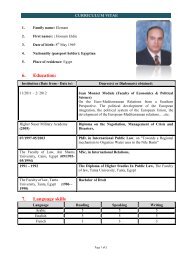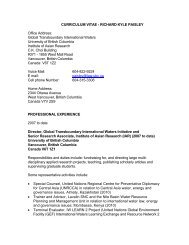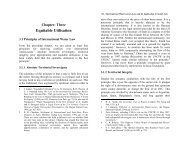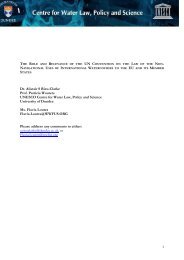Upreti, Trilochan, International Watercourses Law and Its Application ...
Upreti, Trilochan, International Watercourses Law and Its Application ...
Upreti, Trilochan, International Watercourses Law and Its Application ...
Create successful ePaper yourself
Turn your PDF publications into a flip-book with our unique Google optimized e-Paper software.
344 / <strong>International</strong> <strong>Watercourses</strong> <strong>Law</strong> <strong>and</strong> <strong>Its</strong> <strong>Application</strong> in South Asia Appendix / 345Appendix- 5The Helsinki Rules on the Uses of theWaters of <strong>International</strong> Rivers 1966CHAPTER- 1GENERALArticle IThe general rules of international law as set forth in thesechapters are applicable to the use of the waters of aninternational drainage basin except as may be providedotherwise by convention, agreement or binding custom amongthe basin States.Article IIAn international drainage basin is a geographical areaextending over two or more States determined by the watershedlimits of the system of waters, including surface <strong>and</strong>underground waters, flowing into a common terminus.Article IIIA "basin State" is a State the territory of which includes aportion of an international drainage basin.CHAPTER- 2EQUITABLE UTILIZATION OF THE WATERS OF ANINTERNATIONAL DRAINAGE BASINArticle IVEach basin State is entitled, within its territory, to a reasonable<strong>and</strong> equitable share in the beneficial uses of the waters of aninternational drainage basin.Article VI. What is a reasonable <strong>and</strong> equitable share within themeaning of article IV to be determined in the light of allthe relevant factors in each particular case.II. Relevant factors which are to be considered include, butare not limited to:1. The geography of the basin, including in particular theextent of the drainage area in the territory of eachbasin State;2. The hydrology of the basin, including in particular thecontribution of water by each basin State;3. The climate affecting the basin;4. The past utilization of the waters of the basin,including in particular existingutilization;5. The economic <strong>and</strong> social needs of each basin State;6. The population dependent on the waters of the basin ineach basin State;7. The comparative costs of alternative means ofsatisfying the economic <strong>and</strong> social needs of each basinState;8. The availability of other resources;9. The avoidance of unnecessary waste in the utilizationof waters of the basin;10. The practicability of compensation to one or more ofthe co-basin States as a means of adjusting conflictsamong uses; <strong>and</strong>11. The degree to which the needs of a basin State may besatisfied, without causing substantial injury to a cobasinState.III. The weight to be given to each factor is to be determinedby its importance in comparison with that of other relevantfactors. In determining what is reasonable <strong>and</strong> equitableshare, all relevant factors are to be considered together <strong>and</strong>a conclusion reached on the basis of the whole.Article VIA use or category of uses is not entitled to any inherentpreference over any other use or category of uses.












